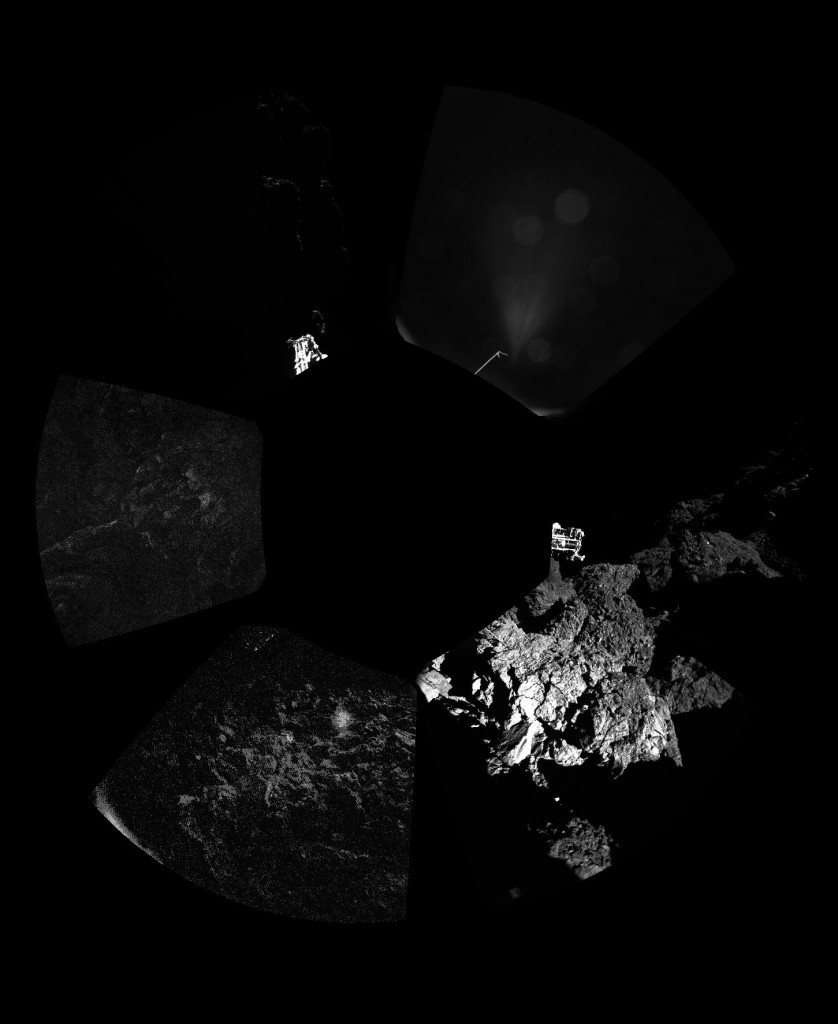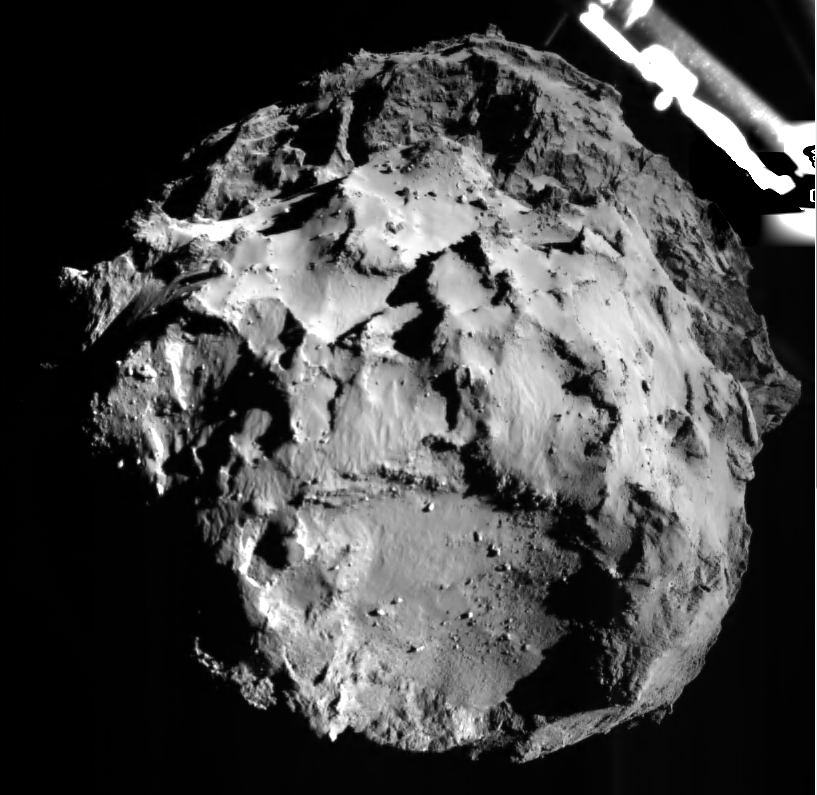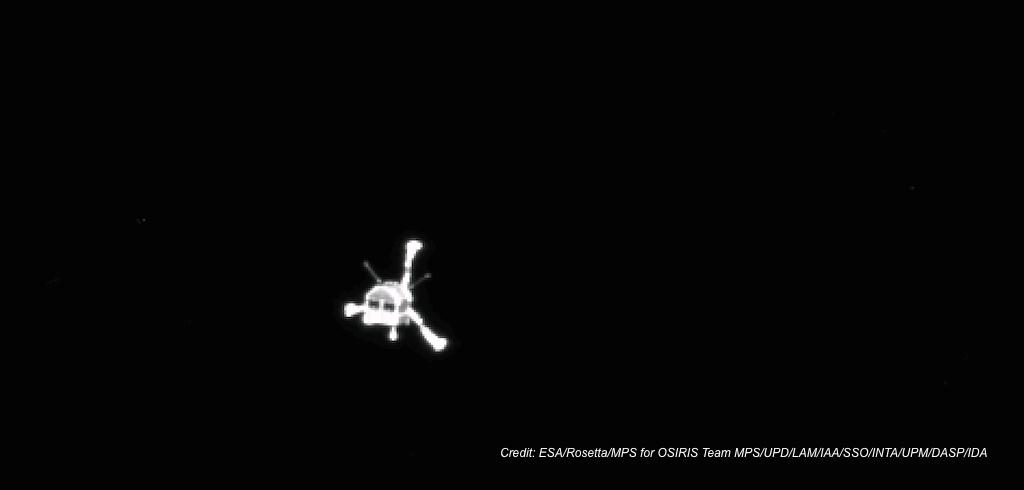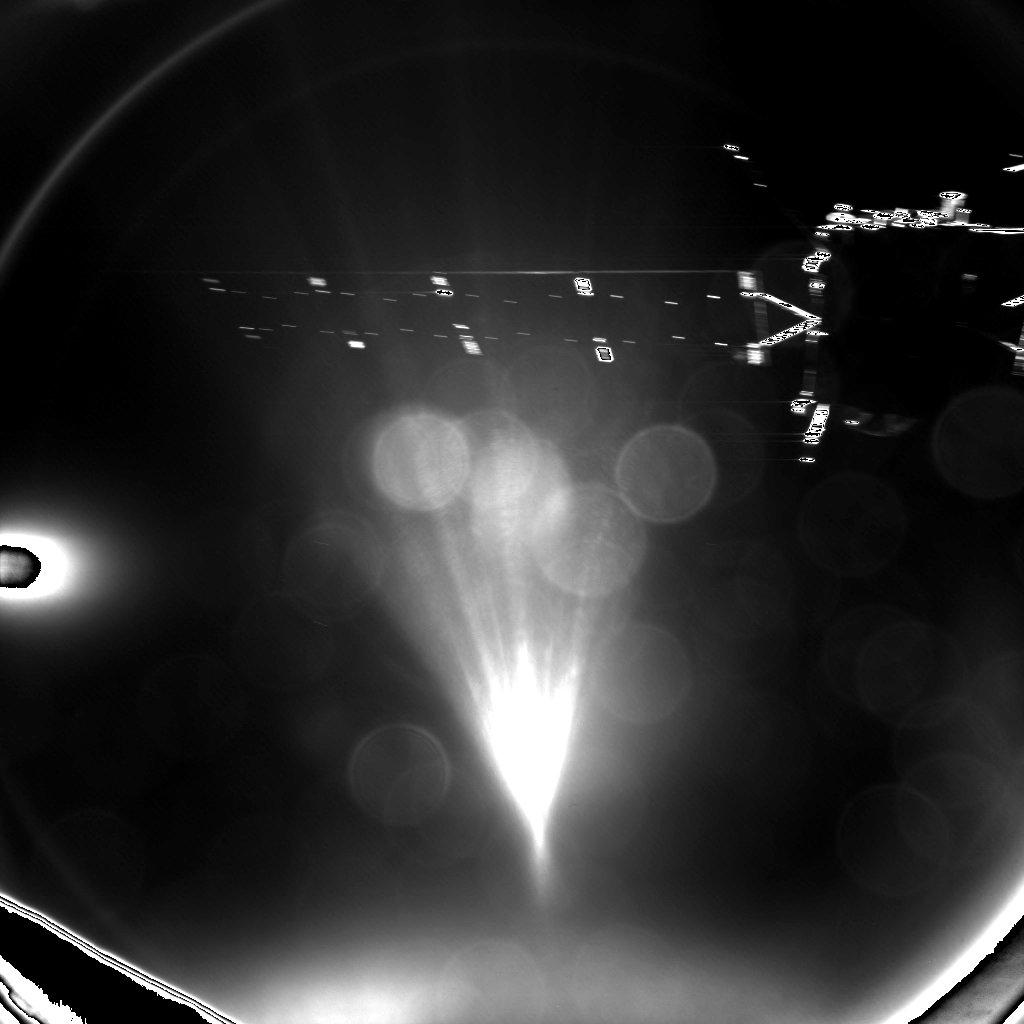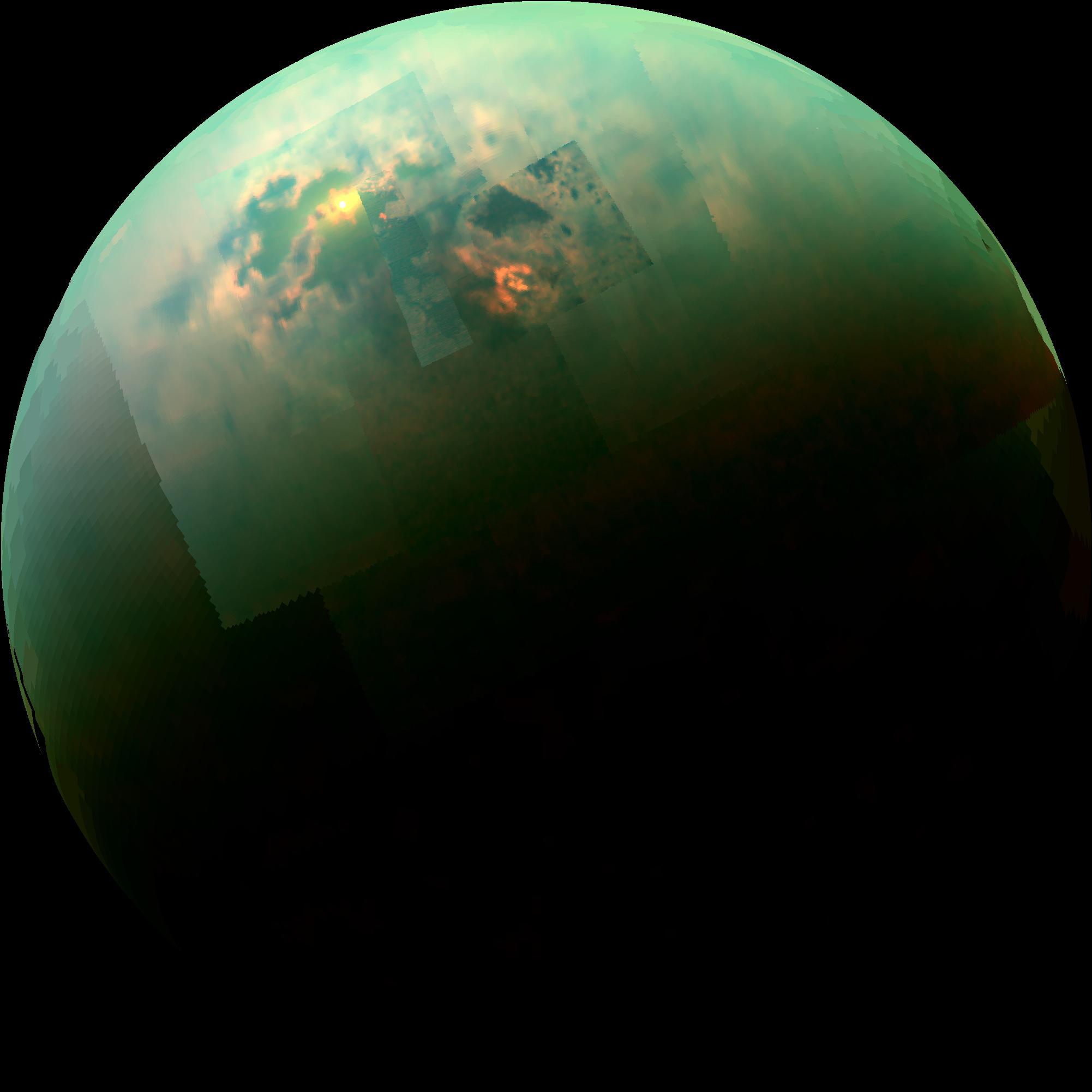It is with some sadness that I report that Philae is asleep. More likely than not, he tipped over, but he may have simply ended up in a shady spot that didn't provide enough solar power. In any case, his batteries have been exhausted and he has powered down. If, by luck of the comets, his solar panels do eventually store up enough energy, he may try to speak to us again. Rosetta will remain in orbit and will keep listening for him.
While there is some sadness, there is also still much cheer. Many, many firsts were accomplished on this mission that I would do well to remember was launched 10 years ago. Philae did transmit a lot of scientific data while operating with his battery. He did land. And the pictures both he and Rosetta took allowed us to see far more detail than we've ever seen. While many were hoping to get more scientific work done on this trip to 67P, it has been quite fruitful already and Rosetta will continue to operate and give us the closest look we've ever had at a comet as it approaches the sun.
Thank you, Philae.
I'm just a human who loves stuff about space. If you're here, you probably do too. I hope you like what I have to say about it.
Wednesday, November 19, 2014
Thursday, November 13, 2014
Philae panorama
So, here's the first panorama of Phila's landing spot:
You can see two of the landing gears pretty clearly at about 11:30 and 3:30. The other one is a bit faint at 7:30. The fact that we have this image is amazing. However, as was pointed out by Emily Lakdawalla, the slice from about 12:00 to 2:00 looks like sky. Either that means Philae is on the edge of a cliff or it's on a slope. Neither are good places to be when the comet starts to become active again. Hopefully, they can figure out the harpoons.
Wednesday, November 12, 2014
Philae landing successful!
So, Philae has landed! We shot a bullet at a bullet and it hit! Not everything is going exactly as planned, however. The thruster meant to counteract the harpoons' recoil was not functioning before separation, but the team went ahead anyway. Now, it appears the harpoons themselves did not fire. While gravity is enough to hold Philae to the comet for now, when the there is more activity closer to the sun, it may no longer be. The harpoons are essential for securing Philae to the main body of the comet.
Despite all this, here's another great picture Philae took during descent. The landing gear appears in the upper right (no, that's not a UFO).
UPDATE: At a press briefing just now, it appears that Philae may have rebounded a bit. The radio link was fluctuating, though consistently re-linked. Some data showed that Philae was rotating for a bit, then stopped rotating. All of this would be consistent with Philae landing, rebounding, then landing again. For the coming hours, Rosetta (our only link to Philae) is below the horizon, so there is no radio link. This particular loss of link was planned and expected, so there is nothing to be concerned with in this regard.
Despite all this, here's another great picture Philae took during descent. The landing gear appears in the upper right (no, that's not a UFO).
UPDATE: At a press briefing just now, it appears that Philae may have rebounded a bit. The radio link was fluctuating, though consistently re-linked. Some data showed that Philae was rotating for a bit, then stopped rotating. All of this would be consistent with Philae landing, rebounding, then landing again. For the coming hours, Rosetta (our only link to Philae) is below the horizon, so there is no radio link. This particular loss of link was planned and expected, so there is nothing to be concerned with in this regard.
First pictures from Philae and Rosetta, post-separation
Tweets are coming fast and furious now (at least by astronomical standards). That seems to be the preferred method of dissemination at the moment. And Philae does indeed look a bit like a fly.
That's, of course, Rosetta taking an image of Philae during his freefall to Comet 67P. Here's a picture of Rosetta, taken by Philae, just after separation.
That's, of course, Rosetta taking an image of Philae during his freefall to Comet 67P. Here's a picture of Rosetta, taken by Philae, just after separation.
Philae getting ready for separation from Rosetta
I'm staying up late tonight to witness history. Humanity is trying to land a spacecraft on a comet. Like one bird watching another bird trying to spit a fly out the end of a straw to catch a bullet, I must see what happens. This fly that them European birds spat out goes by the name of Rosetta. She's already caught up to the speeding bullet known as 67P/Churyumov-Gerasimenko. Now this Rosetta fly is gonna spit out a smaller fly, Philae, to actually land on this bullet. I'll rest some before that happens. There's still some possibility that won't go as planned. After 10 years of hibernation, some parts of Philae appear to be failing. At least the separation is still a go and that will be one for the history books regardless.
Sufficiently advanced technology is indiscernible from magic, indeed.
As I wait for the magic moment, this video warms my thoughts:
Sufficiently advanced technology is indiscernible from magic, indeed.
As I wait for the magic moment, this video warms my thoughts:
Tuesday, November 11, 2014
All Space Considered, November 2014
Planetary News
The big treat of this particular installment of All Space Considered was guest Emily Lakdawalla, Senior Editor and Planetary Evangelist of The Planetary Society. There was a fair amount of solar system news, so she had much to say.Rosetta
First and foremost, Philae is a probe that has been carried by Rosetta out to Comet 67P/Churyumov-Gerasimenko. Rosetta actually arrived at the comet back in August and has since been trying to find a decent landing site for Philae, which will be sent to the surface of the comet. After much deliberation, Philae is almost ready to depart Rosetta. It is happening THIS WEDNESDAY MORNING, 7AM PT. It will be streamed everywhere. Have a look at it! This will be an historic event and there's very little you could possibly be doing that you'd want to miss this for.Siding Spring
One major, major piece of luck (once in 8 million years level of luck) that people studying Mars received was comet Siding Spring passing close enough to Mars to have significant portions of its coma (aka tail) enter the Martian atmosphere. This coincided perfectly with the arrival of MAVEN, which joined six other active spacecraft at Mars. While none of the craft were specifically designed to study comets, MAVEN was designed to study the Martian atmosphere. With so much alien debris raining through the atmosphere, MAVEN was able to provide useful information about the composition of the comet and how that composition interacts with Mars. One big surprise was how quickly some of the materials dissipated. This did not match models, which means we learned something.Misc
Mercury has ice water on it. Yes, Mercury, where temperatures at the surface normally boil water, has ice. Messenger recently sent back pictures confirming that polar craters have regions where there is never sunshine. Like being in the desert at night, these places have nothing regulating the temperature and so are extremely cold.
New Horizons nearing Pluto. New Horizons is nearing Pluto and will start snapping pictures in early 2015. The news for this month was that a second Kuiper Belt object was found for New Horizons to target after it passes Pluto. After several failed searches for such an object with lesser telescopes, Hubble came to the rescue to find a target.
And here's a really pretty picture. There are lakes of hydrocarbons on Titan. Like lakes on earth, if you're in the right place at the right time, you can see the sun reflect off these lakes. Here it is:
Non-planetary News
Private Space Setbacks
The biggest astronomical news was the recent failed launches of an Antares rocket as well as Virgin Galactic's SpaceShipTwo. These were, of course, unfortunate events, especially the loss of life; but there's been plenty of coverage of this elsewhere and I won't dwell on it here.
Lunar Eclipse
There was a total lunar eclipse in October. Lots of pretty pictures were taken and shared by the staff astronomers. And, of course, there was a reminder of the total solar eclipse that will take place on 21 August 2017. It will be visible within just a few hour's drive from almost all of the continental United States, so there is no excuse not to see it. It is an amazing and transformative experience. That said, I don't get too excited about eclipses only because there isn't a lot of science to be gained from them anymore. We've learned much of what there is to learn. However, that doesn't mean I won't stand in awe in August 2017!
As always, I'm sure I've left something marvelous and interesting out. My memory isn't perfect and isn't getting any better over time. If anyone has anything they'd like to add, please let me know in the comments!
Tuesday, September 16, 2014
All Space Considered, June 2014
Lots of little stories this month and just one big one. Unfortunately that big one called BICEP2's results regarding gravitational waves in the cosmic microwave background into question. While the results from March may still hold up, at the moment, scientific consensus does not exist because of the possibility of alternative explanations for their observations.
Jupiter's red spot is shrinking. Compared with the earliest known pictures of Jupiter, the red spot is much smaller and the shrinkage seems to be accelerating. This was bound to happen. Storms can't last forever. However, the disappearance of such a definitive identifying marker would still be a sad occasion.
Magnetars can be big. Well, compared to main sequence stars, they're still small, but they can be bigger than originally thought. One was found that was larger than previous theory allowed and the explanation seems to be that the mass can come from a sister star in a binary system. The angular momentum from the additional mass is enough to help the neutron degeneracy pressure hold up the collapsing star and prevent it from becoming a black hole at higher masses than previously thought possible. This was the best theory since the large magnetar was observed. The big news, however, is that they actually observed the sister star and its characteristics match predictions of this theory.
Russia and the U.S. fighting over space. It's nothing like the Cold War, but Russia's recent actions in the Ukraine have resulted in U.S. sanctions on Russia, meaning what were routine cargo lifts to the International Space Station are under conflict. Some sharp words were exchanged and Elon Musk's SpaceX may come to the U.S.'s rescue.
Illustris, a truly ginormous simulation of the Universe from quite early until now, was recently run. In this simulation, dark matter, gravity and the dynamics of stars (from formation to supernovae) were all taken into account. The simulation was successful in re-creating much of the Universe as we see it. Spiral arms in galaxies, large scale galaxy clusters and the interstellar medium all matched the observable Universe to pretty remarkable accuracy. Once they work out the kinks, the team that ran the simulation is even making the hundreds of terabytes available to the public. Get your hard drives ready!
The International Space Station is now broadcasting live. In addition to pretty mind-blowing pictures...well, just be happy with mind-blowing pictures. You can probably do some extra mind-blowing by manipulating some of the pictures, but if you're reading this, sunrise in space probably tickles your fancy just a little.
The exoplanet revolution continues. A new type of exoplanet was discovered. Previously, exoplanets were generally thought to be either small and rocky like Earth or big and gassy like Jupiter. Kepler-10c, however, is big and rocky. With a diameter 2.5x that of Earth and a mass 17x that of Earth, it is the largest rocky object we've observed, putting it in a new class known as Mega-Earths. This challenges our current planet-formation theories, as anything so large should have enough gravity to hold on to a thick atmosphere.
All Space Considered, September 2014
Here's a quick summary of what we learned about at All Space Considered, September 2014. I'm sure I've forgotten something, as I didn't take notes. Hopefully the other attendees can help out a bit.
Comet Chasers
The NASA probe Stardust flew to a comet. As if that weren't impressive enough, it collected actual comet material while it was there. As if that weren't impressive enough, it came back to Earth with its samples intact. That was actually several years ago, but, as anyone who follows science much at all knows, it's one thing to collect data and another to analyze it all. Just this past month, due to the magic of the crowdsourcing effort Stardust@home, something new was discovered in the data. It turns out some of its collectors not only got comet particles, but captures some of the Interstellar medium as well. As if that weren't impressive enough, the material has been analyzed and contains lots of things that weren't expected.
The ESA, not to be outdone, has sent Rosetta up to an comet. Some very impressive pictures have been sent back already. However, the best is yet to come. They will be landing a secondary probe on the surface of the asteroid. At such proximity, much more can be determined about the composition of the comet than from afar. The lander's instruments will provide quite a wide range of data, including internal and external structure of the comet as well surface and internal material composition.
Aside from the sheer engineering awesomeness of human-made objects syncing up with objects moving thousands of times faster than most humans ever will (at least relative to Earth), what's so great about studying comets? As the solar system formed, much of the inner core material went to make planets and moons. Asteroids are great objects to study because they represent the rocky material that was present when the solar system formed. However, they are generally far too close to the sun and too small to hold onto any non-rocky material. Comets, which generally come in from the Kuiper Belt or Oort cloud, originated much farther away and are much more likely to preserve this truly ancient material. This is somewhat ironic because the Stardust finding is interesting because the interstellar medium it picked up is hypothesized to be newer than any similar material gathered before.
Laniakea
The name means "immense heaven" in Hawaiian. My guess is the people who came up with the word had no idea just how immense the heavens could be. Recently, a gravity map of sorts found an even larger grouping of galaxies to be gravitationally bound than previously thought. Most are well aware that Earth is part of the solar system and that the solar system is part of the Milky Way galaxy. For some time, we've known the Milky Way to be part of a larger grouping called the "Local Group," which is itself part of an even larger grouping known as the Virgo supercluster. Previously, it was thought that this was the largest structure to which the planet Earth belonged to, as anything beyond the Virgo supercluster was not gravitationally bound, meaning that it would, in time, drift away. As it turns out, much more is gravitationally bound to the Milky Way and Virgo supercluster than we thought; and that's what was discovered. It's really worth looking at the animations of the map. It's quite fascinating and, if you're into pyschedelics, psychedelic.
Extremophiles in the Antarctic
Yet more extremophiles were discovered. These happened to be inhabiting an under-ice lake that hasn't seen the light of day for well over 100,000 years, possibly as long as 1,000,000 years. All sunlight is completely blocked at this depth by the ice, so there is no chance of photosynthesis. Yet over 4,000 species found some way to live and reproduce. The intense interest in extremophiles on Earth is a result of a search for life in outer space. The conventional wisdom had long been that certain environments, in fact most environments in outer space, just aren't suitable for life. However, the more we explore similar extreme environments on Earth, the more it looks like life can sustain itself just about anywhere. Further, these sunless, under-ice lakes are likely to exist on the Saturnian moons Enceladus and Titan as well as the Jovian moon Europa. I was personally slightly disappointed to find out these extremophiles were dining on other life. It reduces the chance of such extremophiles being actual initiators and colonizers. However, Titan at least does have vast stores of hydrocarbons along with its under-ice lakes of water, so I should reserve judgment.
Mars parachute
While life on outer moons is certainly tantalizing, exploring Mars is far more cost-effective, both in terms of time and money. NASA tested its LDSD ("low density supersonic decelerator") technology and released some hi-res video of the test. The need for this new technology is a result of ever-increasing payload sizes to the red planet. As we want to explore more and more, we need bigger and bigger vehicles, more and more instruments and, eventually, life support. Mars's atmosphere is a unique challenge. It's far less dense than Earth's, so the drag that can be accomplished by any sort of parachute is far smaller. However, there is an atmosphere, so we can't just plop ourselves down like we did on the moon. While the thing that looks most like the kind of parachute we're used to disintegrates in the video, the primary parachute did deploy successfully and the exact rocket fire to spin the craft up and down were pretty impressive.
Dave Doody from Cassini
So the big treat of this edition of All Space Considered was the appearance of Dave Doody, a Lead Engineer at JPL who works a lot on the Cassini mission. The main bit of news he provided was that funding had been approved by NASA for Cassini to fulfill the entirety of the Solstice mission. This would allow Cassini to continue collecting data on Saturn until it literally runs out of fuel, at which point, the craft will be set to plunge into Saturn. The bulk of what we know about Saturn and its moons has come from the Cassini mission. We've discovered huge water geysers spewing out of Enceladus, hydrocarbon lakes on Titan and gotten absolutely breathtaking photos of the north pole's hexagonal storm. What the Solstice mission promises may not live up to such grandeur, but is pretty exciting just to think about. The probe will be inserted into a polar orbit that will take it between Saturn and its innermost ring, passing at a distance about 1/10th that of the distance from the Earth to the moon. While quite audacious, this is being done by the team that inserted Cassini into orbit within 1s of when it was predicted and put a probe down on the surface of Titan.
Subscribe to:
Posts (Atom)
